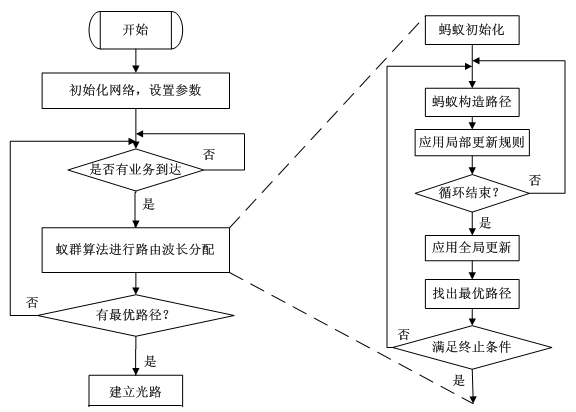Ant-colony-system-based dynamic routing and wavelength assignment method for optical network
A technology of wavelength allocation and optical network, which is applied in multiplexing system selection devices, transmission systems, digital transmission systems, etc., can solve problems such as link congestion, failure to consider wavelength allocation and network balance, and reduce search the effect of time
- Summary
- Abstract
- Description
- Claims
- Application Information
AI Technical Summary
Problems solved by technology
Method used
Image
Examples
Embodiment Construction
[0042] The technical scheme of the present invention is described in detail below in conjunction with accompanying drawing:
[0043] Each ant is responsible for completing the task of routing and wavelength allocation at the same time, that is, at each node, the ant first makes a judgment on wavelength allocation, and then selects a path. Its specific implementation process is as follows figure 1 shown, including the following steps:
[0044] Step1: Network initialization;
[0045] Step2: Determine whether there is business arrival, if yes, jump to Step3, if not, continue to wait;
[0046] Step3: Place all ants evenly and randomly on the source node and destination node, initialize the ants, and randomly select a wavelength;
[0047] Step4: Find the next node. Each ant uses formula (10) to establish the solution of the next node, and uses formula (8) to update the number of local information. If there is no next node to choose, it commits suicide (that is, the ant exits th...
PUM
 Login to View More
Login to View More Abstract
Description
Claims
Application Information
 Login to View More
Login to View More - R&D
- Intellectual Property
- Life Sciences
- Materials
- Tech Scout
- Unparalleled Data Quality
- Higher Quality Content
- 60% Fewer Hallucinations
Browse by: Latest US Patents, China's latest patents, Technical Efficacy Thesaurus, Application Domain, Technology Topic, Popular Technical Reports.
© 2025 PatSnap. All rights reserved.Legal|Privacy policy|Modern Slavery Act Transparency Statement|Sitemap|About US| Contact US: help@patsnap.com



